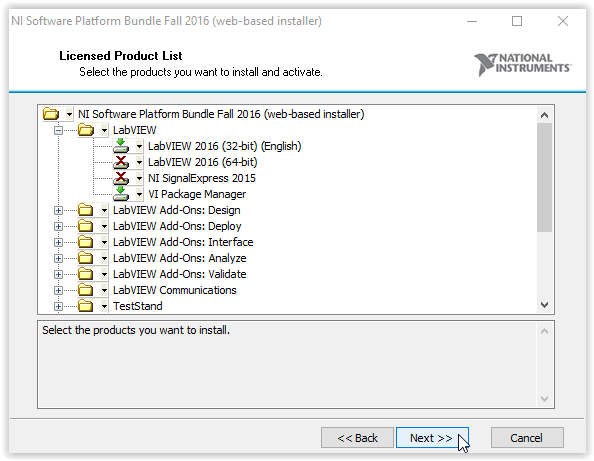

- #How to install labview 2016 32bit 64 Bit
- #How to install labview 2016 32bit serial
- #How to install labview 2016 32bit update
- #How to install labview 2016 32bit 32 bit
- #How to install labview 2016 32bit Activator

#How to install labview 2016 32bit serial
Right click the option to be activated, click “activator” to generate the license and serial number, and the green color will be the activation success.ġ6.
#How to install labview 2016 32bit Activator
Run Ni license activator 1.2.exe in crack cracking folderġ5. Be careful : after installation, the login page of LabVIEW 2019 will pop up, which needs to be closedġ4. You need to shut down your computer to reinstall. This information will not be used to identify or contact you, or to share with third parties. Tip: “by joining the Ni customer experience improvement program, Ni regularly collects data related to your use of our products, and you can help our engineers improve the performance and capability of our products. Start the installation, the process will take more than 20 minutes, just waitġ2. Select “I accept the above 2 license agreements” and “next”ġ1. You can select all of them or check some of them as required. Select the components you want to install. After the previous step is completed, the following interface will pop up. Waiting to install “Ni package manager”ħ. Select “I accept the above license agreement” and click “next”Ħ. Double click install.exe to start the installationĤ.

ISO” to load (Note: the system needs to install the virtual disc), without the virtual disc, right-click the program to decompressģ. Download the corresponding system model in the Baidu network disk provided by this station, download the x86 folder for the 32-bit operating system, and the editor is win7 64 bit, so the 圆4 installation package is tested for youĢ. NI LabVIEW 2019 installation activation tutorialġ. LabVIEW (64 bit) is available in English only. When running on windows (64 bit), LabVIEW (64 bit) can access more memory than is provided by a 32-bit operating system or 32-bit application. Use the LabVIEW platform media to install the modules and toolkits supported by LabVIEW 2019 (32-bit) and LabVIEW 2019 (64 bit).
#How to install labview 2016 32bit update
Operating system: Windows 10 (version 1809) / 8.1 update 1 / Windows 7 SP1 / Windows Server 2012 R2 / Windows Server 2008 R2ĬPU: Pentium 4m / Celeron 866 MHz (or equivalent) or higher (32-bit) Pentium 4 G1 (or equivalent) or higher (64 bit)
#How to install labview 2016 32bit 64 Bit
This was over the period of about 2 days trying different things and I'm sure some of the stuff I tried, but can't remember, contributed to the final success.Software name: NI LabVIEW 2019 v19.0.1 64 bit / 32-bit simplified Chinese Special Edition (registration machine + tutorial attached) Software size: 1.62GB Updated: Then MESA (whatever that is) and finally the kernel source to get VISA. Then I had to symlink them because it still couldn't find them.
#How to install labview 2016 32bit 32 bit
The main things I remember this time round are that I had to install the relevant 32 bit libraries piece-by-piece (2012 is only 32 bit on Linux) as the installer complained about them. Previously I stuck religiously to OpenSuse 32bit with KDE because that just worked out of the box. I had to install LV2012 on Centos 7.2 (64bit with Gnome) this time around. When they say "supported" they mean you can phone up to get support and not get stone-walled Mine isn't Ubuntu but Centos which is supported but even that wasn't trivial. You end up trying so many different things to get it to work you don't really know what parts were crucial. Maybe the last time I somehow succeeded in having VISA working on a nonsupported distro was in 2008. If I'd be to bother about VISA, I think I always stumbled in noncompilable kernel modules. I usually never bother to get VISA really working, I only use the installations for code-checking and algo developement, GUI without being too picky about font look (which however somewhat improved with 2016). On those two systems I can confirm the installations survive to distribution upgrades, the files just sit in /usr/local/natinst/. INSTALL.sh gives an obscure ]] not expected syntax error", and an "ok, let's copy all the *.rpm to /tmp and alien -i them". How do I do, I forget year after year, immediately after I succeed. I have LV12, 13, 14, 15 on my desktop (probably ubuntu 12 release upgraded to 14) and 14, 15, 16 on my laptop (ubuntu 14 upgraded to 16).


 0 kommentar(er)
0 kommentar(er)
